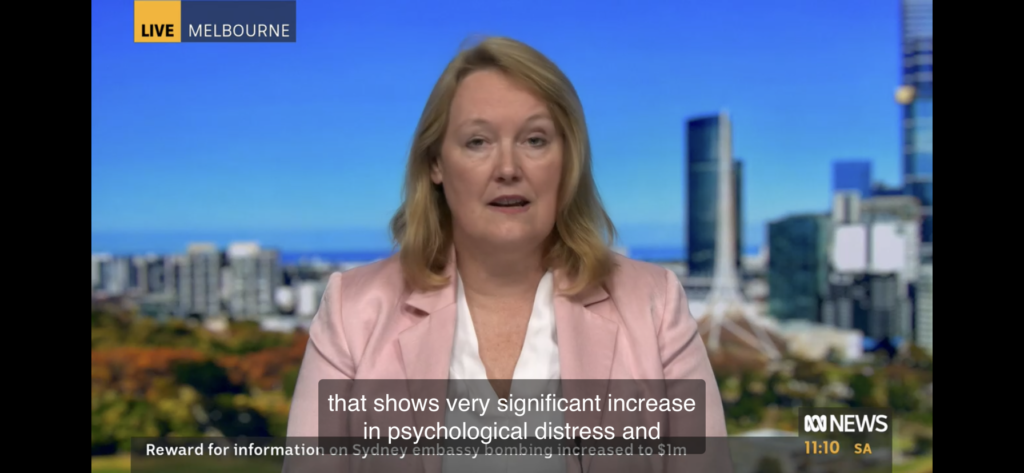Australian women have lower income, less labour force engagement and poorer health than men, a report has found.
The first Australian Women’s Health and Wellbeing Scorecard: Towards equity for women found that at current rates it will take 70 years to reach full time employment equality with men, and more than 200 years to reach income equity.
Women’s labour force absence alone cost $72 billion in lost GDP annually, driving health inequities and deterioration, prompting calls for urgent action.
Building on a successful Monash University partnership with Monash Health and over 100 other organisations, the Monash Centre for Health Research and Implementation (MCHRI) will produce the scorecard annually. It was published today in MJA InSight+
Overall, The Women’s Health and Wellbeing Scorecard found economic indicators for women were improving but that a gender gap remains for all indicators except unemployment.
In this context, more women than men experienced elevated psychological distress, which has risen sharply in women aged 18-24 and 55-64 since 2001, linked to financial inequity.
Women aged 18-24 reported the highest distress in all years since 2001. Women aged 55-64 went from reporting the lowest distress in 2001 to the second highest in 2018.
“I look back over my life of hard work and family dedication, yet know I can only look forward to major financial struggles, and tough times ahead. I worry every day about keeping my rental accommodation and being able to manage the basics in my life. It just seems unfair.” – recent retiree Heather.
The report found that many self-reported indicators of physical health deteriorated over the past decade and women with lower incomes consistently experienced poorer health than others.
It is largely based on the nationally representative data from the annual Household, Income and Labour Dynamics in Australia (HILDA) survey.
The report found women have poorer labour force outcomes, lower incomes, and less superannuation than men. These outcomes are improving slowly, but gender gaps remain large, particularly around full-time employment, labour force absence, income and superannuation.
Report co-authors, MCHRI Women’s Economics and Value Based Care Unit lead Associate Professor Emily Callander, and MCHRI Director Professor Helena Teede, a leading women’s health expert, said equitable health and wellbeing was a social justice issue and critically linked to financial equity and accessible prevention and healthcare.
They said the report confirmed that women were failing to make progress in terms of health, well-being and equity.
“Poor health is known to reduce income; and low income is known to increase risk of poor health creating a cycle of disadvantage for Australian women, with impact on women from diverse backgrounds even greater,” Professor Teede said.
“Poor health, low income and absence from the labour force comes at enormous cost, presenting a key barrier to future prosperity. Women disproportionately have lower income, and less engagement in the labour force, which drives poorer health, even in a high-income country like Australia.”
Professor Teede said the report highlighted key health and wellbeing indicators where women had poorer outcomes than men – but this should not be the status quo.
“Removing the structural barriers that prevent equality is an urgent priority to prevent the declining health of women in Australia,” she said.
“Urgent action is required to address women’s health and wellbeing, through a women-centred, evidence-based approach – focused on achieving real change for women. Implementation of evidence, monitoring and accountability here is imperative.”
MCHRI is working towards a world-first integrated Australian Women’s Public Health, Wellbeing and Equity Institute to address these challenges.
Associate Professor Callander said: “Having good health, meaningful employment and a decent level of income and wealth allows individuals to fully participate in and contribute to society. These are also vital for health, wellbeing and for economic growth.”
Watch an interview with Prof Helena Teede on ABC News here

Some of the media reports include:
The Guardian: Australian women will need ‘more than 200 years’ to reach income equity with men.
Some of the report’s highlights include:
- Women’s average income and superannuation balances increased from 2001-2020, but women continued to have lower income and less superannuation than men.
- In 2020, there was a 19-percentage point gap in full time employment, a $23,767 annual income gap and a $44,746 superannuation gap between men and women.
- Women’s social functioning, emotional and physical ability to perform their role, declined from 2001-2020, linked to financial inequity.
- In 2020, women reported poorer health outcomes than men in every health domain except general health.
- Around two thirds of women report poor physical functioning, low levels of vitality and poor general health and mental health.
- Women’s health in many domains is going backwards; most reported poor health in mental health, physical and social functioning, emotional and physical ability to perform a role, vitality and bodily pain.
- Low-income women had poorer health than high income women in every domain of health assessed. There was a more than 20 percentage point gap between lowest and highest income women for most domains.
- The largest gap was for physical ability to perform a role where 61% of women in the lowest income group experienced poor health in this domain; but only 26% of women in the highest income group did. Similar differences were seen for general health, physical and emotional ability to perform a role, physical functioning, and bodily pain.




